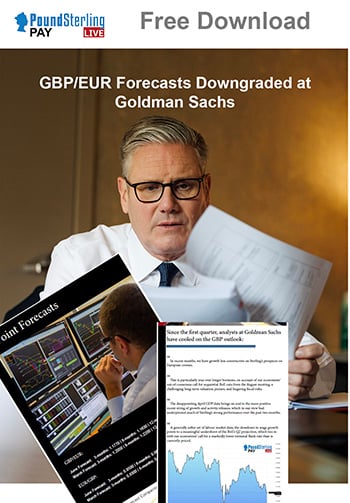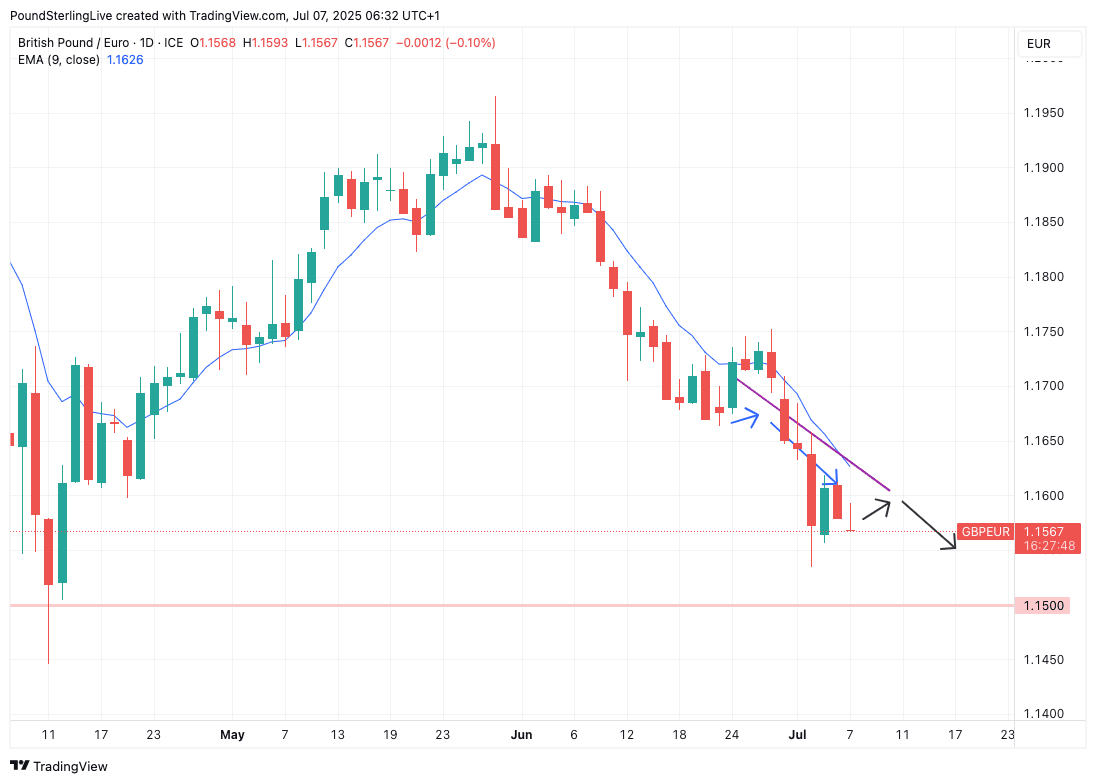- GBP/EUR technicals look for near-term rebound
- But Sterling to stay offered
- Trade tensions weigh on sentiment Monday
- UK fundamentals offer little support

Image © Adobe Images
Pound Sterling is set to remain pressured by the Euro, even if it can put in some short-term relief bounces.
The Pound to Euro exchange rate starts the new week under renewed selling pressure amidst renewed trade tensions, and our Week Ahead Forecast sees a high likelhood of it ending the current week lower than the 1.1568 level it opened at.
The British Pound started the current selloff wave on May 29, having reached as high as 1.1965, and we think it is on course to test at least 1.15, the April low, before the current down wave completes.
From a technical perspective, the exchange rate sits below the nine-day exponential moving average (EMA), which is acting as a cap on any advances and confirming downside momentum is intact.
That being said, in the near term, we could see a recovery to the nine-day EMA, which is at 1.1626 on Monday, as the pair does tend to mean-revert. The drop at Monday's open means the exchange rate has deviated from its nine-day EMA by enough to trigger the need for said mean reversion:
Above: GBP/EUR at daily intervals with Week Ahead Forecast annotations.
Then important point to make is that any spells of strength are unlikely to be durable in nature. The above chart shows the blue arrow annotations we drew on Monday June 23, which is two weeks ago.
It shows that we thought a shallow bounce was likely ahead of an extension of the selloff, as mean-reversion to the nine-day EMA took place. That prediction proved to be the correct assumption.
We think the same pattern can repeat in the coming days (black lines), so gains as high as 1.1630 are possible, and the pair could even end this week above 1.16.
However, the big takeaway is that gains are consolidative at best as we target an eventual downside extension to 1.15 at some point in the next two weeks.
The new week starts with renewed concerns about the global economic outlook, and international stock markets are softer. President Donald Trump has again raised trade tensions by saying the U.S. will start issuing tariff letters to countries as soon as Monday.
"I am pleased to announce that the UNITED STATES TARIFF Letters, and/or Deals, with various Countries from around the World, will be delivered starting 12:00 P.M., Monday, July 7th," said Trump on his Truth Social platform.
Those partners lucky enough to be at the negotiating table, will be told that "if you don’t move things along, then on August 1 you will boomerang back to your April 2 tariff level," said U.S. Treasury Secretary, Scott Bessent.
U.S. Commerce Secretary Howard Lutnick meanwhile said the unilateral imposition of tariffs by the U.S. would commence from August 01, suggesting the scope of any big trade deals is rapidly narrowing.
This impacts GBP/EUR through two channels: 1) The exchange rate traditionally falls during periods of market weakness as the Pound has a higher 'beta' to investor sentiment and 2) the Euro is the major beneficiary during times of elevated trade tensions.
So we have that global backdrop that explains the soggy Monday start for the British Pound.
However, the currency also faces strengthening domestic headwinds, with last week seeing a breakdown in sentiment towards the UK on renewed fears the country's debt was becoming unsustainable.
Although Chancellor Rachel Reeves remains in her position, something that calmed markets that were worried she might be fired, it doesn't change the material facts of the case: The UK is massively in debt and that debt is only going to grow.
Reports over the weekend suggested tax rises were inevitable. With the tax burden being at post-war records, it means the likelihood those tax increases realise significantly higher revenues for the government are vanishingly small.
Instead, they are likely to shrink the tax base and slow the economy, meaning the Pound will continue to face significant risks in the coming months as fears about the outlook crop up.


